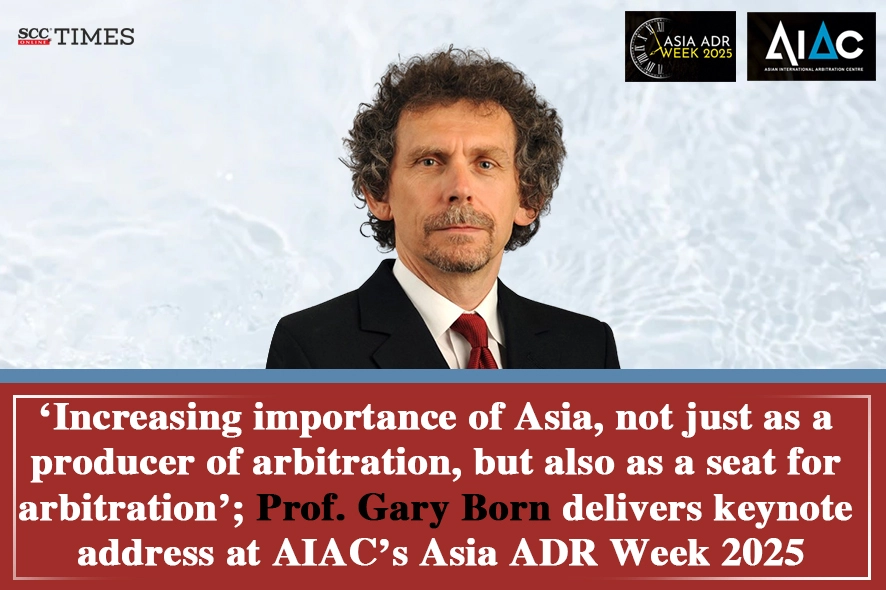The seventh edition of the Asian International Arbitration Centre (AIAC)’s Asia ADR Week, 2025 began with its much-awaited first day. Set against the dynamic backdrop of Asia’s evolving dispute resolution landscape, this year’s event invites global practitioners, thought leaders, and stakeholders to explore the timely opportunities shaping the future of Alternative Dispute Resolution.
After the first panel discussion on the topic “From Code to Clause: Discovering AI Footprint on the Efficiency, Ethics and Evolution of Arbitration”, Professor Gary Born, Chair of the International Arbitration Practice Group, Wilmer Cutler Pickering Hale and Dorr LLP, delivered a keynote speech on the august occasion.

Underscoring how international arbitration has become the least lawful means of resolving international commercial or investment disputes worldwide, Prof. Born highlighted the reasons why this mechanism has proven popular with businesses and governments over the last several decades. He stated that there were six Es, which were aspirations and realized objectives or achievements, which were the advantages of international arbitration. These are as follows:
-
Expertise: Parties are able to choose experts for their specific disputes instead of Courts, which have generalized judges. Thus, the arbitrators have greater expertise on the specific matter for which they are chosen.
-
Expedition: It is faster than Courts due to the lack of procedures or multiple appellate processes in many jurisdictions. It is also more expeditious because arbitral institutions like AIAC have provisions for emergency arbitration and expedited procedures for small-value disputes.
-
Efficiency: It is more efficient as it reduces costs by being expeditious. Institutions also play an important role in ensuring that arbitration is expeditious and efficient.
-
Even-handedness: Parties can mutually agree on a neutral and objective arbitral seat with a choice of selected subject guidelines. This ensures impartiality, and there is no risk of home court justice.
“No party, rightly or wrongly, wants to litigate on its counterparty’s home turf.”
-
Enforceability: International Arbitration is more enforceable due to forum selection clauses and the UNCITRAL model law, which assures parties that their agreement will be respected and enforced by national Courts worldwide.
-
Electronic ability: It is more electronic, which saves costs and enhances the expeditiousness of the process, as many aspects of the arbitration can be conducted remotely or virtually.
Thereafter, Prof. Born spoke about how arbitration had significantly increased when one looks at arbitral institutions’ caseloads, and Asia had stood out particularly. In this regard, he demonstrated that Asia seated cases in international arbitration had risen from 2% in 1995, to 4% thereafter, then 10% by the 2010s, and almost doubled by now.
“Some of the first ICC cases have been Asia-seated, that is a very significant reflection of the increasing importance of Asia, not just as a producer of arbitration, but also as a seat for arbitration.”
He highlighted that some jurisdictions, such as Singapore, i.e., Singapore International Arbitration Centre(‘SIAC’), have progressed from a few cases in 1995 to tens of cases in 2024. Other Asian Institutions, like the Dubai International Arbitration Centre, AAIC, and Hong Kong International Arbitration Centre (HKIAC), have also had a significant increase in their influence and dockets.
“In the past, one might have looked to the Courts in Wales, or perhaps the United States, or Switzerland, for the key developments in international arbitration. Today, one sees here in Asia, Courts taking the lead in the development of international arbitration law and its practice.”
Remarking how Asian Courts had also become more influential in terms of their decisions on international arbitration, Prof. Born shed light on a few important cases from India, Hawaii, Malaysia, and Singapore, which he believed attracted support from outside Asia or the Pacific region.
In conclusion, he expressed that International Arbitration Institutions, irrespective of the jurisdiction, had been at the core of developing new institutional rules, or new adaptations to those rules aimed at facilitating the procedure, such as the streamlined procedure of SIAC. This pinpointed the important successes of the field in the past three to four decades. Lastly, he complimented the efforts of every jurisdiction in developing the international arbitration regime to provide better service to the clients.



